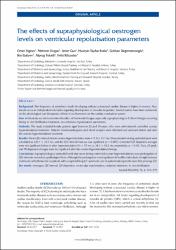| dc.contributor.author | Yiğiner, Ömer | |
| dc.contributor.author | Doğan, Mehmet | |
| dc.contributor.author | Gün, İsmet | |
| dc.contributor.author | Kutlu, Hüseyin Tayfun | |
| dc.contributor.author | Değirmencioğlu, Gökhan | |
| dc.contributor.author | Güliyev, İlkin | |
| dc.contributor.author | Tokatlı, Alptuğ | |
| dc.contributor.author | Kılıçaslan, Fethi | |
| dc.date.accessioned | 10.07.201910:49:13 | |
| dc.date.accessioned | 2019-07-10T20:01:35Z | |
| dc.date.available | 10.07.201910:49:13 | |
| dc.date.available | 2019-07-10T20:01:35Z | |
| dc.date.issued | 2018 | en_US |
| dc.identifier.citation | Yiğiner, Ö., Doğan, M., Gün, İ., Kutlu, H. T., Değirmencioğlu, G., Güliyev, İ. ... Kılıçaslan, F. (2018). The effects of supraphysiological oestrogen levels on ventricular repolarisation parameters. Kardiologia Polska, 76(6), 974-979. https://dx.doi.org/10.5603/KP.a2018.0037 | en_US |
| dc.identifier.issn | 0022-9032 | |
| dc.identifier.issn | 1897-4279 | |
| dc.identifier.uri | https://dx.doi.org/10.5603/KP.a2018.0037 | |
| dc.identifier.uri | https://hdl.handle.net/20.500.12511/3353 | |
| dc.description | WOS: 000435195800008 | en_US |
| dc.description | PubMed ID: 29399762 | en_US |
| dc.description.abstract | Background: The frequency of arrhythmic death developing without a structural cardiac disease is higher in women. Also, female sex is an independent risk factor regarding development of torsades de pointes. Several studies have been conducted on the physiological and therapeutic effects of sex hormones on the cardiac conduction system. Aim: In this study we aim to examine the effect of hormonal changes, especially supraphysiological E2 level changes occurring during in vitro fertilisation treatment, on ventricular repolarisation parameters. Methods: The study included female patients aged between 23 and 39 years, who were administered controlled ovarian hyperstimulation treatment. Patients' electrocardiograms and blood samples were obtained and analysed before and after the ovarian hyperstimulation treatment. Results: Mean QTc intervals before ovarian hyperstimulation were 411.9 +/- 23.7 ms. Measurements during oestradiol peak were calculated as 420.7 +/- 23.3 ms, and the QTc interval increase was significant (p = 0.007). Corrected QT dispersion averages were not significant before or after hyperstimulation (53 +/- 17 ms vs. 54.5 +/- 18.2 ms, respectively, p > 0.05). Tp-e, J-T peak, and PR dispersion changes were not significant after the ovarian hyperstimulation therapy. Conclusions: Supraphysiological oestradiol levels that occur during controlled ovarian hyperstimulation cause prolongation of QTc intervals, but not to a pathological level. Although this prolongation is not significant in healthy individuals, it might increase ventricular arrhythmia risk in patients with congenital long QT syndrome and in patients taking medication that prolongs QT. | en_US |
| dc.language.iso | eng | en_US |
| dc.publisher | Via Medica | en_US |
| dc.rights | info:eu-repo/semantics/openAccess | en_US |
| dc.subject | Oestrogen | en_US |
| dc.subject | QT Interval | en_US |
| dc.subject | QT Dispersion | en_US |
| dc.subject | Ventricular Repolarisation | en_US |
| dc.subject | Ovulation Induction | en_US |
| dc.subject | In Vitro Fertilisation | en_US |
| dc.title | The effects of supraphysiological oestrogen levels on ventricular repolarisation parameters | en_US |
| dc.type | article | en_US |
| dc.relation.ispartof | Kardiologia Polska | en_US |
| dc.department | İstanbul Medipol Üniversitesi, Tıp Fakültesi, Dahili Tıp Bilimleri Bölümü, Kardiyoloji Ana Bilim Dalı | en_US |
| dc.identifier.volume | 76 | en_US |
| dc.identifier.issue | 6 | en_US |
| dc.identifier.startpage | 974 | en_US |
| dc.identifier.endpage | 979 | en_US |
| dc.relation.publicationcategory | Makale - Uluslararası Hakemli Dergi - Kurum Öğretim Elemanı | en_US |
| dc.identifier.doi | 10.5603/KP.a2018.0037 | en_US |
| dc.identifier.wosquality | Q2 | en_US |
| dc.identifier.scopusquality | Q3 | en_US |


















